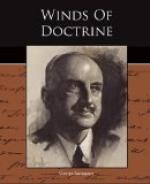Again, take the somewhat disconcerting assertion that movement exists when there is nothing that moves, and no space that it moves through. In vision, perhaps, it is not easy to imagine a consciousness of motion without some presentation of a field, and of a distinguishable something in it; but if we descend to somatic feelings (and the more we descend, with M. Bergson, the closer we are to reality), in shooting pains or the sense of intestinal movements, the feeling of a change and of a motion is certainly given in the absence of all idea of a mobile or of distinct points (or even of a separate field) through which it moves; consciousness begins with the sense of change, and the terms of the felt process are only qualitative limits, bred out of the felt process itself. Even a more paradoxical tenet of our philosopher’s finds it justification here. He says that the units of motion are indivisible, that they are acts; so that to solve the riddle about Achilles and the tortoise we need no mathematics of the infinitesimal, but only to ask Achilles how he accomplishes the feat. Achilles would reply that in so many strides he would do it; and we may be surprised to learn that these strides are indivisible, so that, apparently, Achilles could not have stumbled in the middle of one, and taken only half of it. Of course, in nature, in what non-Bergsonians call reality, he could: but not in his immediate feeling, for if he had stumbled, the real stride, that which he was aware of taking, would have been complete at the stumbling-point. It is certain that consciousness comes in stretches, in breaths: all its data are aesthetic wholes, like visions or snatches of melody; and we should never be aware of anything were we not aware of something all at once.




